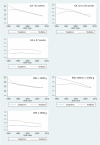Decreasing cerebral palsy prevalence in multiple births in the modern era: a population cohort study of European data
- PMID: 32847831
- PMCID: PMC7907575
- DOI: 10.1136/archdischild-2020-318950
Decreasing cerebral palsy prevalence in multiple births in the modern era: a population cohort study of European data
Abstract
Multiple births (twins or higher order multiples) are increasing in developed countries and may present higher risk for cerebral palsy (CP). However, few studies can reliably investigate trends over time because these outcomes are relatively rare.
Objective: We pooled data from European CP registers to investigate CP birth prevalence and its trends among single and multiple births born between 1990 and 2008.
Design: Population cohort study.
Setting: 12 population-based registers from the Surveillance of Cerebral Palsy in Europe collaboration.
Participants: 4 446 125 single and multiple live births, of whom 8416 (0.19%) had CP of prenatal or perinatal origin.
Main outcomes: CP diagnosis ascertained in childhood using harmonised methods; CP subtype; Motor impairment severity among CP cases.
Results: The rate of multiple births increased from 1990. Multiples displayed higher risk for CP (RR=4.27, 95% CI 4.00 to 4.57). For singletons and multiples alike, risk for CP was higher among births of lower gestational age (GA) or birth weight (BW). However, CP birth prevalence declined significantly among very preterm (<32 weeks) and very low BW (<1500 g) multiples. Singletons and multiples with CP displayed similar severity of motor impairment.
Conclusions: Between 1990 and 2008, CP birth prevalence decreased steadily among multiples with low GA or BW. Furthermore, multiples with CP display similar profiles of severe motor impairment compared with CP singletons. Improvements in management of preterm birth since the 1990s may also have been responsible for providing better prospects for multiples.
Keywords: epidemiology; multiple births; neonatology; neurodisability.
© Author(s) (or their employer(s)) 2021. Re-use permitted under CC BY-NC. No commercial re-use. See rights and permissions. Published by BMJ.
Conflict of interest statement
Competing interests: None declared.
Figures
References
-
- Ghosh K. Birth characteristics in England and Wales: 2017. Stat Bull Off Natl Stat 2019:1–14.
-
- Martin JA, Hamilton BE DP, et al. National Vital Statistics Reports Births : Final Data for 2013. Statistics 2015;64:1–104. - PubMed
MeSH terms
LinkOut - more resources
Full Text Sources
Medical
Miscellaneous

